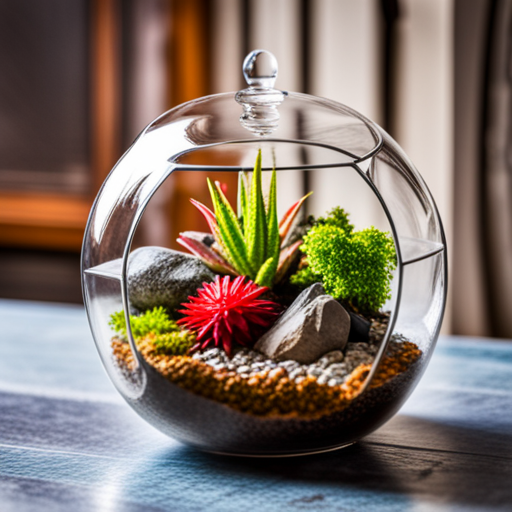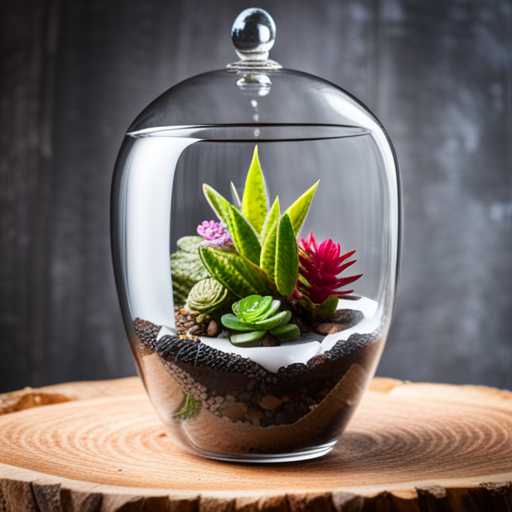Terrarium Ideas for you! If you’re looking to take your indoor gardening hobby up a notch, terrariums may just be the perfect project for you. Not only are these mini gardens visually stunning, but they can also provide a relaxing and peaceful atmosphere to any room of your home. With careful consideration of plants, soil type, watering, and light requirements, your unique terrarium can thrive for years with minimal upkeep. Keep reading to discover all the tips and tricks you’ll need to create an amazing terrarium that looks like it was professionally designed–all without spending a fortune!
Types of Terrarium Ideas – Open vs Closed
Different Terrarium ideas, miniature gardens enclosed in glass, are becoming increasingly popular among nature enthusiasts. The two main types of these indoor gardens are open and closed terrariums. The open terrariums are generally larger, allowing more air circulation and more choices in plants. They require less maintenance but can be prone to drying out if not watered regularly. On the other hand, closed terrariums are more moisture-retentive and suitable for plants that thrive in humid environments. They come in smaller sizes and require minimal watering and pruning. Choosing the right type of terrarium depends on your preferences and the plants you want to grow. Whatever your choice, terrariums are an excellent way to bring a green touch into your home or office.
Best Types of Plants for Your Terrariums
Terrariums are a beautiful way to bring a touch of nature into any space. Not only do they add an extra element of decor, but they also provide a healthy environment for a variety of plants.
Open Terrarium Plants

Open terrariums are perfect for plants that don’t require a lot of humidity to thrive. Here are some great terrarium ideas for plants:
– Ferns: These lush plants have delicate leaves and fronds, which look beautiful when displayed in an open terrarium. Different varieties can tolerate different light levels and soils, so be sure to do your research before setting up your terrarium.
– Succulents: These trendy, low-maintenance plants come in a wide variety of shapes and colors, making them a great choice for open terrariums. They require plenty of light and little watering once established.
– Mosses: These hardy plants are perfect for adding texture and color to your terrarium. They grow well in low light, don’t require frequent watering, and can be propagated quite easily.
– Ivy: These trailing plants make a great addition to any open terrarium, providing texture and contrast to the overall design. Ivies prefer bright indirect sunlight, so be sure to place them where they’ll get enough light.
Closed Terrarium Plants
Closed terrariums are a great choice for humid and moisture-loving plants like mosses and ferns. Here are some other suitable closed terrarium idea plants:
– Tropical Orchids: These beautiful, exotic flowers make a stunning centerpiece in any closed terrarium. They require more maintenance than other plants, including higher humidity levels and frequent watering.
-African Violets: These delicate flowers come in a range of colors and sizes, making them a great choice for closed terrariums. They prefer bright indirect light and will bloom year-round with proper care.
– Mosses: As mentioned above, mosses are perfect for adding texture and color to your terrarium. They thrive in the humid environment of a closed terrarium and require little care.
– Air Plants: These unique succulents don’t require any soil and absorb water from the air, making them an ideal choice for closed terrariums. They come in many varieties and provide a unique look to your terrarium.
– Ferns: Ferns are classic choices for closed terrariums as they prefer more shaded environments and thrive in high humidity. Different varieties have different light and moisture requirements, so be sure to do your research before setting up your terrarium.
Whatever plants you choose, be sure to pay attention to their specific care needs for the best results in your terrarium!
Soil for Terrariums
The type of soil you choose for your terrarium ideas will depend on what kinds of plants you’re growing. Generally, open terrariums require well-draining soil rich in organic matter. Closed terrariums need more moisture-retentive soils. You can use a combination of potting soil and organic matter like compost, peat moss, or coco coir to create the perfect terrarium soil. Be sure to avoid planting mixes with heavy fertilizers, as these can cause problems in your terrarium.
When and how much to water your Terrarium
When it comes to watering your terrarium, less is more. It’s best to water just enough to keep the soil moist but not soggy. This is especially important for open terrariums as too much water can cause mold and mildew problems. For closed terrariums, you can mist the plants with a spray bottle or use a hand mister to increase humidity. If you’re not sure when to water your terrarium, stick your finger in the soil and feel for moisture – if it’s dry, give it a light watering.
Light Requirements for a Healthy Terrarium
Creating a healthy terrarium requires more than just choosing the right plants and filling them with soil. Light is a crucial component that can greatly impact the health of your terrarium. Different plants have varying light requirements, so it’s important to research each plant’s needs before placing them in your terrarium. While some plants thrive in low-light environments, others require ample sunlight to photosynthesize and grow. Consider the direction and intensity of light that your terrarium will be exposed to throughout the day and choose plants accordingly. Be sure to also monitor the distance between the light source and your plants, as too much or too little light can cause damage. Keep an eye on your plants and if they are suffering move your terrarium to a different spot. Play around and experiment with your terrarium and remember to have fun!
Common Pests in Terrariums and How to Treat Them
Pests in terrariums can quickly become a frustrating and annoying problem for any green thumb enthusiast. However, with the right knowledge and tools, these pests can be easily treated and prevented from invading your terrariums in the first place. Some of the most common pests found include mites, mealybugs, thrips, and fungus gnats. The first step in treating these pesky creatures is to properly identify them, as each pest will require a different treatment approach. Prevention can also go a long way in keeping your terrariums pest-free. Regularly cleaning and monitoring your plants, using sterile soil and avoiding overwatering are all ways to prevent a pest infestation. Do not let pests ruin the beauty of your terrariums and use these tips to enjoy healthy and thriving plants.
Fertilizer for terrarium plants – How Much and How Often
Terrariums are miniature ecosystems that require proper care to thrive. One of the most important aspects of maintaining a healthy terrarium is ensuring that plants receive the necessary nutrients. Fertilizer is essential for plant growth, but determining the right amount and frequency can be tricky. Over-fertilization can harm plants, while under-fertilization can stunt growth. To find the sweet spot, consider the type of plants in your terrarium, their growth stage, and the fertilizer’s concentration. Generally, a diluted liquid fertilizer applied once a month during the growing season is sufficient. However, it’s always best to monitor the plants’ health closely and adjust fertilization accordingly. By providing the right amount of fertilizer at the right time, your terrarium plants will flourish and contribute to a stunning indoor display.
How to Create Contrast in Your Terrarium
Adding different textures, colors, and shapes is the best way to create contrast in your terrarium and make it out. Consider the plants, decorations, and materials that you have available and use them to create visual interest. Natural items such as stones, driftwood, shells, or moss are great for a rustic look. You can also use colorful glass, pebbles, crystals, or figurines to draw the eye. When it comes to plants, create contrast by including species of different sizes and shapes. Place taller plants in the back and shorter ones in front for a layered look. Finally, think about using contrasting colors throughout your terrarium such as bright green foliage against darker brown rocks or white stones against lush green moss. With these tips, you can easily create a visually-appealing terrarium that will be the centerpiece of your home.
Happy Gardening!
In conclusion, a terrarium is a great way to bring the outdoors inside, and it can be extremely fun to design and create your own. There are an endless number of possibilities for creating something unique for your own terrarium ideas. With careful consideration of the type of setup, light requirements, soil types, watering needs, pest treatment, and fertilizer, you can feel confident that your terrarium will be on its best behavior. By following these guidelines, you’re sure to have everything you need to make your terrarium thrive for years to come. So if you’re looking for a creative and unique way to brighten up your living space or just need something new to try with nature – jump right in and start creating your terrarium today!
Please be sure to check out my Gardening Blog Post Page for more tips on all types of gardening. Including Seed Saving, Seed Starting, Orchids, Water Gardening, Coldframe Gardening, Indoor Bulb Gardening, Hydroponics, Container Gardening, Mums, Herbs, African Violets, planting Bulbs, Flower Gardening, Vegetable and Fruit Gardening, Indoor Houseplants of all kinds, Cactus, Succulents, Hanging plants, Deer resistant plants and even Bird, Bee, Butterfly and Hummingbird Gardens!

